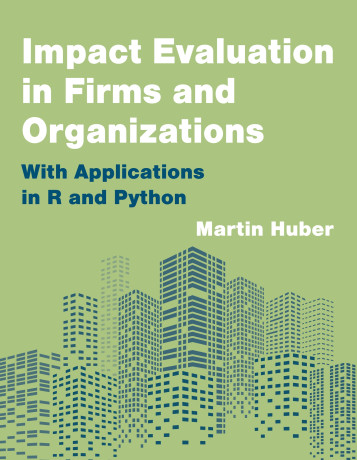Impact Evaluation in Firms and Organizations
With Applications in R and Python
by Huber
| ISBN: 9780262552929 | Copyright 2025
Instructor Requests
In today's dynamic business climate, organizations face the constant challenge of making informed decisions about their interventions, from marketing campaigns and pricing strategies to employee training programs. In this practical textbook, Martin Huber provides a concise but comprehensive guide to quantitatively assessing the impact of such efforts, enabling decision-makers to make evidence-based choices.
The book introduces fundamental concepts, emphasizing the importance of causal analysis in understanding the true effects of interventions, before detailing a wide range of quantitative methods, including experimental and nonexperimental approaches. Huber then explores the integration of machine learning techniques for impact evaluation in the context of big data, sharing cutting-edge tools for data analysis. Centering real-world, global applications, this accessible text is an invaluable resource for anyone seeking to enhance their decision-making processes through data-driven insights.
- Highlights the relevance of AI and equips readers to leverage advanced analytical techniques in the era of digital transformation
- Is ideal for introductory courses on impact evaluation or causal analysis
- Covers A/B testing, selection-on-observables, instrumental variables, regression discontinuity designs, and difference-in-differences
- Features extensive examples and demonstrations in R and Python
- Suits a wide audience, including business professionals and students with limited statistical expertise
| Expand/Collapse All | |
|---|---|
| Contents (pg. vii) | |
| Preface and Acknowledgments (pg. ix) | |
| 1. Introduction (pg. 1) | |
| 2. Basics of Impact Evaluation (pg. 7) | |
| 2.1. The Fundamental Problem of Impact Evaluation (pg. 7) | |
| 2.2. Characterizing the Impact (pg. 8) | |
| 2.3. The Problem of Comparing Apples to Oranges (pg. 12) | |
| 3. Experiments (A/B Testing) (pg. 19) | |
| 3.1. Comparing Apples to Apples (pg. 19) | |
| 3.2. Behavioral Assumptions and Methods for Analyzing Experiments (pg. 22) | |
| 3.3. Multiple Interventions (pg. 26) | |
| 3.4. Use Cases in R (pg. 29) | |
| 3.5. Use Cases in Python (pg. 33) | |
| 4. Selection on Observables: Aim to Compare Apples with Apples (pg. 37) | |
| 4.1. Making Groups Comparable in Observed Characteristics (pg. 37) | |
| 4.2. Behavioral Assumptions (pg. 41) | |
| 4.3. Methods for Impact Evaluation (pg. 42) | |
| 4.4. Use Cases in R (pg. 49) | |
| 4.5. Use Cases in Python (pg. 54) | |
| 5. Causal Machine Learning (pg. 59) | |
| 5.1. Motivating Causal Machine Learning (pg. 59) | |
| 5.2. Elements of Causal Machine Learning (pg. 63) | |
| 5.3. A Brief Introduction to Several Machine Learning Algorithms (pg. 64) | |
| 5.4. Effect Heterogeneity and Optimal Policy Learning (pg. 69) | |
| 5.5. Use Cases in R (pg. 74) | |
| 5.6. Use Cases in Python (pg. 80) | |
| 6. Instrumental Variables (pg. 87) | |
| 6.1. Instruments and Complier Effects (pg. 87) | |
| 6.2. Behavioral Assumptions and Methods (pg. 89) | |
| 6.3. Use Cases in R (pg. 93) | |
| 6.4. Use Cases in Python (pg. 96) | |
| 7. Regression Discontinuity Designs (pg. 99) | |
| 7.1. Sharp and Fuzzy Regression Discontinuity Designs (pg. 99) | |
| 7.2. Behavioral Assumptions and Methods (pg. 102) | |
| 7.3. Use Cases in R (pg. 107) | |
| 7.4. Use Cases in Python (pg. 109) | |
| 8. Difference-in-Differences (pg. 111) | |
| 8.1. Difference-in-Differences and the Impact in the Treatment Group (pg. 111) | |
| 8.2. Behavioral Assumptions and Extensions (pg. 114) | |
| 8.3. Use Cases in R (pg. 117) | |
| 8.4. Use Cases in Python (pg. 119) | |
| 9. Synthetic Controls (pg. 123) | |
| 9.1. Impact Evaluation When a Single Unit Receives the Intervention (pg. 123) | |
| 9.2. Behavioral Assumptions and Variants (pg. 124) | |
| 9.3. Use Cases in R (pg. 128) | |
| 9.4. Use Cases in Python (pg. 131) | |
| 10. Conclusion (pg. 133) | |
| References (pg. 135) | |
| Index (pg. 139) | |
Martin Huber
Martin Huber is Professor of Applied Econometrics at the University of Fribourg, Switzerland, where his research comprises both methodological and applied contributions in the fields of causal analysis and impact evaluation, machine learning, statistics, econometrics, empirical economics, and business analytics. He is the author of Causal Analysis: Impact Evaluation and Causal Machine Learning with Applications in R (MIT Press).|
eTextbook
Go paperless today! Available online anytime, nothing to download or install.
Features
|

